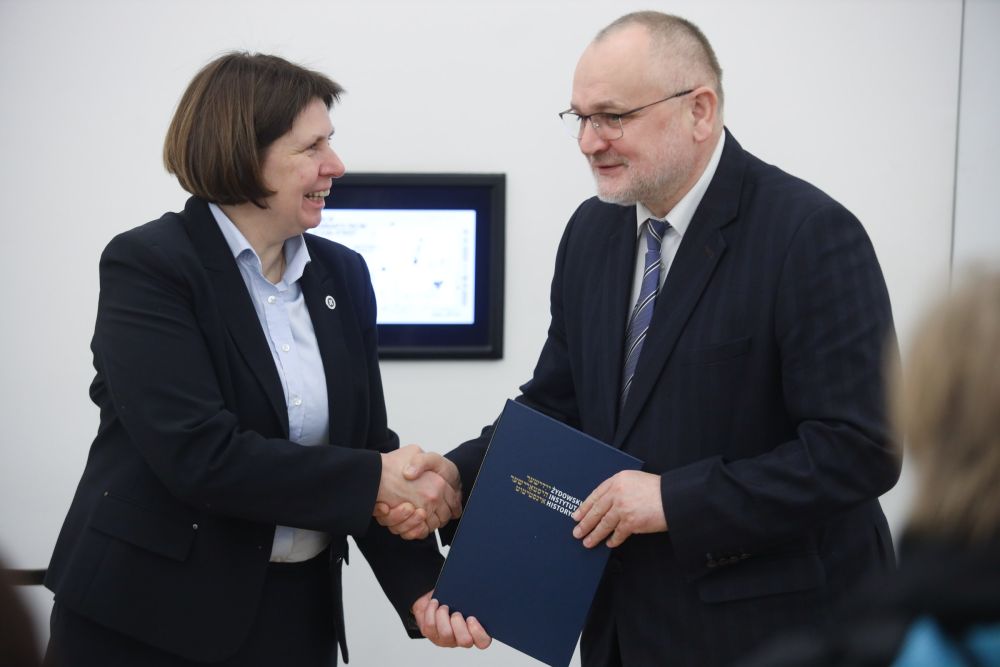- News
- Events
- Oneg Shabbat
- Collections
- Research
- Exhibitions
- Education
- Publishing Department
- Genealogy
- About the Institute
- Bookstore


fot. Grzegorz Kwolek, JHI
Dr. Piotr Szpanowski, deputy director of the Department of Cultural Heritage at the Ministry of Culture and National Heritage, was present at the meeting.
The conference began with director Monika Krawczyk, discussing the importance of the collections kept at the Jewish Historical Institute for the upcoming exhibition.
– The Jewish Historical Institute houses a resource initiated by the Central Jewish Historical Commission, which collected and documented events related to the period of German occupation during World War II so that German crimes were documented by the testimonies and accounts of direct witnesses of the Holocaust. The JHI is also the place where the Warsaw Ghetto Archive is kept. The activities of our scientists guarantee the highest level of historicity, adequacy and use of the collections. The Germans completely destroyed the extermination camp in Treblinka, but thanks to the reports of the Oneg Shabbat group, authentic documents were obtained, among others the account of Jakub Krzepicki, who escaped from Treblinka that we present at our permanent exhibition, as well as the plan of the Treblinka extermination camp from 1942, prepared from memory by one of the escapees.
– At this moment, the construction of a modern museum building has begun at the Treblinka Museum – said director Edward Kopówka. – It should be mentioned that the person who lobbied for the construction of the building was Samuel Willenberg of blessed memory, for many years the only living prisoner of the extermination camp. Now the person who promotes it further and is very involved is his widow, Ada Krystyna Willenberg. I’m glad that Samuel’s dreams are coming true. The heart of every museum facility is the permanent exhibition and once again I would like to thank the Institute for cooperating with us, I would like to thank Prof. Andrzej Żbikowski, who will head this team, I would like to thank all the JHI employees who will be part of this team.
– As the Jewish Historical Institute, we are obliged to the Jews of Warsaw, but not only – began his speech Prof.Andrzej Żbikowski.– Almost a million people were murdered in Treblinka, they were Jews from the central part of the General Government, from the Białystok District. We owe memory to all of them. The memory of these people is the most important thing.
Then Prof. Żbikowski talked about his vision for the permanent exhibition at the Treblinka Museum.
– In Warsaw, we have several groups of researchers investigating the history of Polish Jews, especially those from Warsaw. I dream that each of these communities would have something to say in this team, show their vision, and point out the aspects of necessary sensitivity and social expectations. We realize that over eighty years have passed and everything looks different in the memory of contemporary Warsaw residents. We need to ask what they expect. We want this exhibition to be traditional in some way, to commemorate people, and in some way – modern.
Then, director Edward Kopówka presented Monika Krawczyk with the Medal of Merit for the Treblinka Museum awarded to the Jewish Historical Institute, and director Krawczyk presented director Kopówka with a commemorative badge of the Jewish Historical Institute.
We are glad that with the signing of the agreement, the cooperation between the Jewish Historical Institute and the Treblinka Museum, which has been ongoing for over twenty years, has become even closer. We believe that it will result in a substantive, valuable and interesting exhibition in the new building of the Museum.